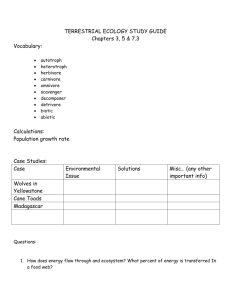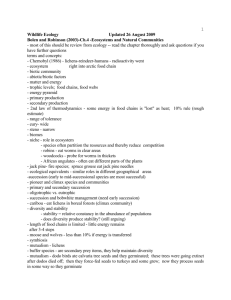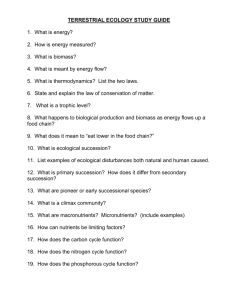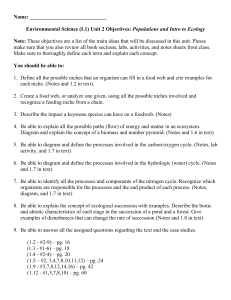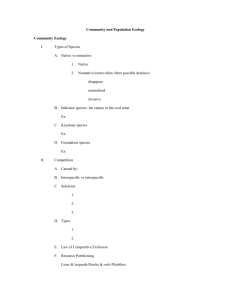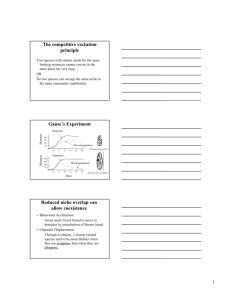How do plant communities change over time?
advertisement
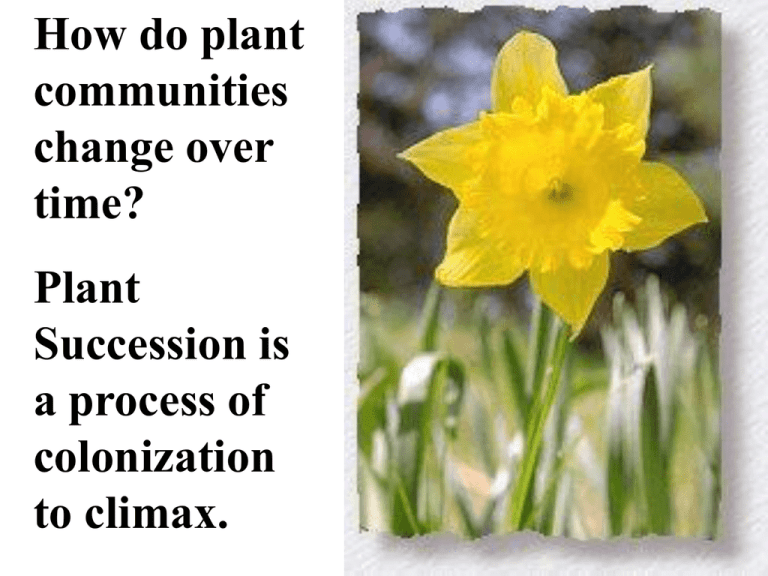
How do plant communities change over time? Plant Succession is a process of colonization to climax. Succession = communities in an area change over time into a different community Community = populations of all species living + interacting in an area Association = certain species commonly found together Different Wildlife use Different Stages of Successional Environments Species Characteristics • EARLY • LATE • • • • Sunloving Fast growing Fast to reproduce Lots of small seeds • • • • • • • • • Smaller biomass Broad niche Biodiversity low Interactions low Ecosystem stability low • • • • • Shade tolerant Slow growing Slow to reproduce Larger seeds (more stored food) Larger biomass Narrow niche Biodiversity high Interactions high Ecosystem stability high EASTERN U.S. SUCCESSION HAS DECIDUOUS TREES AS CLIMAX (NORTH WESTERN forests have conifers as climax type) Bare Soil Colonizing Old Field Forest Which Organisms Take Over? • First to arrive (Colonizers) • Tolerance of environment • Early Colonizers tend to: –grow rapidly = sun loving –mature quickly –reproduce with small seeds in large numbers Seed Dispersal is a Critical Component of Soil Colonization Colonizers change habitats • Plants hold windblown soil + seeds • create soil with decomposition (add organics + biomass) • create shading/cooler/hold moisture • This allows new species with different habitat requirements to come in Early Successional species include mosses + lichens • Facilitation: The organisms at a given successional stage make the environment more suitable for later successional stages. • Examples: lichens breaking down rock into soil, nitrogen-fixing plants Mosses + lichens capture windblown seeds + soil, allowing herbs grow Many annual + perennial herbs are also early successional species Non-native Species • Tend to be early successional • Tend to have no predators (chemical defenses/interactions) • Aggressive and Fast growing • Can be extremely disruptive to ecosystems • Examples: cheatgrass, Himalayan blackberry, English ivy, clematis, holly Shrubs and young trees invading a field continue succession Early-successional habitats are declining due to development, loss of farmland, natural plant succession and the absence of fire. They are also degraded by the invasion of non-native plants Cottonwood trees in a mid successional forest Climax: the end point of a successional sequence, a community that has reached a steady state under a particular set of environmental conditions. Oregon “old growth” climax forest Climax Steppe-Shrub in Eastern Oregon – Go Sagebrush! Plant Succession PRIMARY vs... SECONDARY • Primary succession = sequence of communities developing in a newly exposed habitat devoid of life • starts with bare rock or newly exposed mineral soil (no organic material, no seeds) i.e. lava flows, sand dunes, volcanoes, mines, landslides, bulldozers Glaciers covered the Puget Sound about 12,000 years ago Glaciers scraped the surface clean and lands recolonized Colonizing a bare slope . Big Fires can kill all life = 1 succession Primary Succession means: •No living plants •No organisms in the soils •No Organic material in soils SECONDARY = partial disturbance • sequence of communities taking place on sites that have already supported life • ie. Abandoned farms, clearcut forests, burned areas, etc. • i.e. tree falls, small fires, disease/insect impacts, storm damage. Disturbance: an abrupt event that removes individual organisms or biomass and opens up space (or frees resources) which can be exploited by other organisms. Disturbances vary in spatial scale, intensity, frequency, and type. SECONDARY SUCCESSION = •Question is, how much disturbance = what type? Primary or Secondary? http://www.youtube.com/watch?v=CQ2Xl6ZqzRI Small fires may only remove some of . the vegetation = this is 2 succession Some species of plants only reproduce after a fire Species Characteristics • EARLY • LATE • • • • Sunloving Fast growing Fast to reproduce Lots of small seeds • • • • • • • • • Smaller biomass Broad niche Biodiversity low Interactions low Ecosystem stability low • • • • • Shade tolerant Slow growing Slow to reproduce Larger seeds (more stored food) Larger biomass Narrow niche Biodiversity high Interactions high Ecosystem stability high
